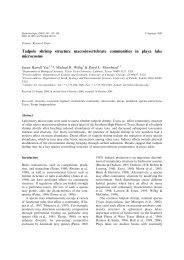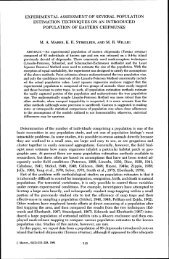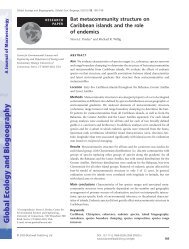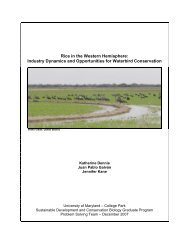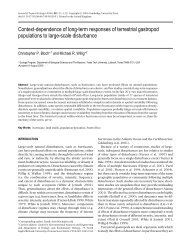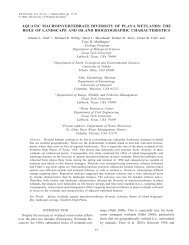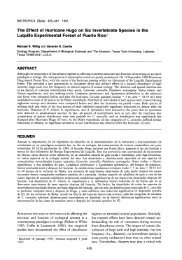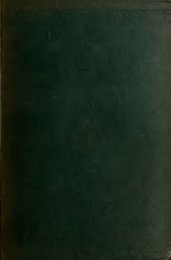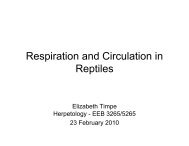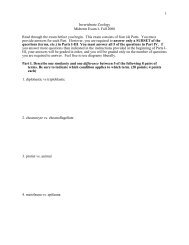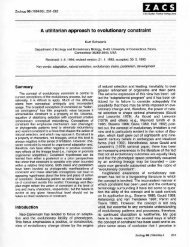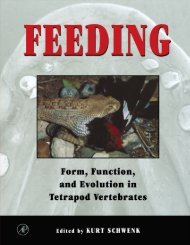The minimum equipment necessary to collect insects consists
The minimum equipment necessary to collect insects consists
The minimum equipment necessary to collect insects consists
Create successful ePaper yourself
Turn your PDF publications into a flip-book with our unique Google optimized e-Paper software.
Collecting and Preserving [nsects<br />
ColtEcrrNG and preserving insett" i'an idPal way lo learn-aboul<br />
them. and can b.;n interesling hobby lt provides lhc salisfaction<br />
ol leaming at 6rst hand, and enables l he collt clor lo discover things<br />
ulour in.i.r. lhat he mjght not learn lrom books lt also provides<br />
materiat for the study oistructural details that serve as identifrcation<br />
characters. Tfere are few restrictions against <strong>collect</strong>ing<br />
<strong>insects</strong> compar.d <strong>to</strong> lho:e for collecl-ing olher animals or plants'<br />
<strong>The</strong> average landowner has no oUjecl lon <strong>to</strong> lnst ct coll( cll'lg on nls<br />
prop.nv, ind it is only in a feu'plaer-' )uch a: park. wh're coliectine<br />
mav be re'tricted. Insecl. are so aburdanl thal ordlnary<br />
coll"ci]ne has little or no elle(( on their numbers: the 'ludenl o[<br />
<strong>insects</strong> n'eed nol worry Ihat hi. <strong>collect</strong>irrg actirilit5 $ill upset lhc<br />
balance of nature.<br />
When and Where <strong>to</strong> Look for Insects<br />
Insects occur almost evervwhere, and the more places you<br />
examine the rnore kinds of <strong>insects</strong> you are likely <strong>to</strong> find. Insects<br />
are small and live in small habitats; different species may often be<br />
Iound only a few inche. or a lew ieel aparl. ll you know where lo<br />
Iook. vou'can lind at least some insect' virtually any lime, bllt<br />
collccrirq rvill be morc nrohlable lrom 'prinr <strong>to</strong> Iall than in the<br />
winler- bifierent ins"ct. are active at differert lime" oi the year.<br />
hence <strong>collect</strong>ing throughout the year rvill yicld a wider range of<br />
<strong>insects</strong> than <strong>collect</strong>ing for only a part of the year.<br />
You can beein vour co)lecting at home, \vhere you may hnd<br />
insecr. on o'tJ. oi infesting iooJ, clolhing, and other malerialc<br />
On warm eveninqs ouldooa insectc are atlraclcd <strong>to</strong> porch lights<br />
and rvindows of lfihted rooms.<br />
A good place ou-tdoors <strong>to</strong> look for in:, ct' is on plant.;each planl<br />
willa-ttra,.icertain spccies. Olhcrin.ecl5occur in \ariou'conccaled<br />
siruation". 'uch as in leaf litler or dpbric, under .lones or other<br />
obiecls. in funqi. under bark, in dead logs, in decaying materials,<br />
anl in rhc grou-nd. Many in.ects live in water..eilher.lhroughout<br />
their lives or during lheir immature slage'. and may be louno tn<br />
differcnt Darls ol specialized aquatic habitat". Adult. ol <strong>insects</strong><br />
occurring'in water bnly during ihcir immature slage" are usually<br />
found near water.<br />
COLLECTINC EQUII'MENT<br />
Collecting Equipment and How <strong>to</strong> Use It<br />
<strong>The</strong> <strong>minimum</strong> <strong>equipment</strong> <strong>necessary</strong> <strong>to</strong> <strong>collect</strong> <strong>insects</strong> <strong>consists</strong> of<br />
your hands and a container for the insccts <strong>collect</strong>ed. Certain <strong>to</strong>ols<br />
are very he)p[ul, nonetheless. For gencral <strong>collect</strong>ing they include<br />
a net, hilling jars, vials of preservative, envelopes, and small boxes;<br />
other <strong>to</strong>ols are useful in some tvpes of <strong>collect</strong>ing. A pair of forceps<br />
is excellent for handling <strong>insects</strong>, as is a hand lens lor examining<br />
them. Many of thesc items can be carried in a shoulder bag; the<br />
forceps and hantl lens can bc carricd on a string around your neck.<br />
<strong>The</strong> Net. A net lor gcneral <strong>collect</strong>ing should be light and strong<br />
and have a fairll'open mesh so that it can be srvung easily and an<br />
insect can bc sccn through it. <strong>The</strong> size may depencl on your personal<br />
preference, but most nets have a handle 211<strong>to</strong> 3 ft. long and<br />
a rim about 1 ft. in diameter; the bag shoulrl be about trvice as long<br />
as thc diametcr of thc rim, and rounded at the bot<strong>to</strong>m. Marquisette,<br />
scrim, bobbinet, ancl bolting cloth arc good materials for the<br />
bag, which should have a heavier nlaterial, such as muslin, around<br />
the rim. A fine-mesh bolting cloth is probably the best material<br />
for the bag of a net that will be used prinarily for srveeping.<br />
Insect nets can be purchased from a supply house (prices ranging<br />
upward lrom a ferv dollars) or they can be homemade; homemade<br />
nets cost considerablv less. AD insect net can be made tvith a broom<br />
handle or similar stick, a wire for the rim, and a cloth bag, as shown<br />
in thc illustration on the next page. If you prefer a net that can be<br />
taken apart and carried inconspicuously, use the frame of a fishlanding<br />
net, rvhich you can buy lrom a sporting-goods s<strong>to</strong>re.<br />
An insect nct can be used in 2 general ways: you may look lor<br />
an insect and srving at it or you may simply st'ing the net through<br />
vegetation. <strong>The</strong> first method requires a ccrtain amount of speed<br />
and skill, especially for active or fast-flying <strong>insects</strong>. <strong>The</strong> second<br />
method, usually callecl "sweeping," can yield a considerable<br />
quantity and variety o[ small <strong>insects</strong>.<br />
Insccts caught in a net can be temoved in various lvays. Take<br />
care <strong>to</strong> prevent their escaping before you take them out of the Det.<br />
Removc them with as little resultant damaee as oossible and -<br />
in the case of in"c.l" rhar bire or.ring rr'il-our injury ro yourself.<br />
You can keep an active insect from escaping by quickly<br />
turning the net handle <strong>to</strong> fold the bag over the rim.<br />
Most <strong>insects</strong> can be removed from a net by grasping them<br />
through the net rvith the fingers. Small or fragile <strong>insects</strong>, easily<br />
damaged by this method, can be removed in these ways: (1) by<br />
inserting a box or bottle in<strong>to</strong> the net and getting the insect directly<br />
in<strong>to</strong> this container; (2) by rvorking the insect in<strong>to</strong> a fold of the net<br />
and placing this fold in<strong>to</strong> a killing jar <strong>to</strong> stun the insect; or (3) by<br />
removing the insect rvith an a,piraror r-ec p. a). Thc fir"l method<br />
is the one usetl bv manv colleclor' Io remove buller0ies or moths
C)<br />
fr<br />
E<br />
COLLECTING EQUIPMENT COLLECTING EQUIPMENT<br />
<strong>The</strong> homemade insccr nel. Cut grooves oppo'it' .iks ol. olt<br />
"n<br />
end ot handle, a. shorvn in \, I <strong>to</strong> aboL.t 2 in. i om in.j and tlre<br />
'" 3 in. from end;Jri ' a hole aboul hrlf$n) rhro!'sh<br />
"Gi t""Jt" "U.'i .",1 of each groore Bend $ire Inr r:m raLour No 8<br />
*^"".<br />
"i r; +.'^;n B, nt nro l'o'es and groort'. Jnd- idslcn il<br />
ihcrc rith 6ne 'ri-. or hcavl ,ord (cr ('ur malFrrxl lor blg as<br />
.h.t"" ;n I and serv. Completed bag, x'ith muslin around rim,<br />
ls snown ln I,<br />
Irom a nel. 'ince direct handlirrg ol t\t.pecimen ofl'n causcs som'<br />
^f th^ q.,lp- *ii"-i"U" rd he rrrhhed rubbed off. off lt l-f a bullcrdv burrcrdv of molh molhi5 r5 graqped b)<br />
"iifl"<br />
(<strong>to</strong> reducc flutteing<br />
Many beginncr. may Le rcluctant -il:i;;'i<strong>to</strong>;;;';; <strong>to</strong> insect ror rea,<br />
thal il mighl miq;l bite -ai or sling: iting; such is Is is mr much mu'-h less likelY lil
COLLLCTINC I'qUTP]II,NT<br />
Por:.-iun ,.arid \\"i,I' [,ol 'ikr:us.rf.r i' u'ualr avai]allcat<br />
a drrrgrrn-e. Tl e <strong>to</strong>xic '-r'nt ir :r ,)arl lP Ja I' frv lroJen.')an'oe.<br />
an ,.:
IO<br />
COLLECTING EQUIPMENT<br />
in<strong>to</strong> a vial or other container' This container has intake and mouthpipcL<br />
tub* , nlerinq it: lhc inlal. lubP i" u.urlll a piece o[ ra in<br />
elas" rubina xbout n ir. lone, and the moulhll'ce luue IS ri.ll'<br />
!las- rubirf lhrough l]re cork plu' I r2 lo 2 'l (r1 rubber lubrrg,<br />
ivirh a pl"ti.f clo-th over Ihe inner cnd lo nrevc'l ir'r'r-t" from<br />
beinc sucked inlo lhc rnoulh llac' ll-e cnd of the Inlake lube<br />
close-<strong>to</strong> the insect and suck through the mouthpiece. An asplra<strong>to</strong>r<br />
is u.eltl for collrctirrg.mall, nut loo sLlir, ir:e(ls. eilh'I lrom a'l<br />
in"ect net. a Dldll. o'r rnolher 5ilualion <strong>The</strong> in:cct' coll cte'l<br />
"o<br />
mav Le leDl ilire nr lrarr"ferr.d ro r, killine jar.<br />
Traps. in",,t trdp: can Le ron5lrur ted in r'rriou'r3)s alld Ihe<br />
attraiiarl u",J wili ,l,termir. rhr t;pe" of irr'eLr" likely <strong>to</strong> be<br />
caught. Tn" irltraclanl rraJ Lc crlifrcirl lieht. decar''rg m''at or<br />
fruii, or orher thing.. Trre lrapr ar.,on:lructed :o Ilri'tt on't thc<br />
in.".,. o.t in rh.r iannol gel oul somc lrapc cu'h a' 1fo'e wilh<br />
liitlrt r"'thc allr;crant) mav bc con'trucled Io direcl lhe cauehl<br />
in_sects cvcntuallv in<strong>to</strong> a coltaiDcr o[ alcohol or a killing jar;others<br />
t'rift t* n" ft.''r".1 u irh d"..rl ing ll.aterial' ) Inav hc cun5l ru( ted<br />
lo dirccr<br />
". lhe in.rct. inrn i:p,cial , ha.1bcf and .lol inlo lhc Lrarl'<br />
lc.eLr" artracte'l ru lighri o bait. mry ofttr be 'ollntcd by<br />
hand or rvith a nP , $il\ou1 use o[ a tr.rp lnscct'allracl'Ll lo a<br />
lieht. for , xarnple, cd'r L,, collecr' Ll dir''' tr) int''' a krllrrr{ J€r or<br />
oiher cor'trin,r shpn rhey alight nn .orn, 'ulracr' ne.rrby (a.l ghl<br />
colore,t t"oll ot sheet). Tirus jiou can collcct only those specirnens<br />
in nh:rh r'ou rr. Da-licularly irtere.ted<br />
Aquatii Collect'ing Equipment. \4ary aluat ic ir'c' ls can be<br />
collcired hr hen.1 oi uir\ forc.ps fron obje,ls in lhc \\'dier: moll<br />
car L-,c.ollecled $itlr a nel oroilrer oLrire. A' aqudli' rel'hould<br />
br much lhalr un a,ricl nel,Milhabagno'leep(r ll'an ll'P<br />
"turditr<br />
diameter of the rim. Kitchen straincrs i[ <strong>to</strong> 6 in. in diameter make<br />
good dip nets.<br />
ii" i;o-""' or .trainrr c.n.s up full ol mud ar.l debri', rhe<br />
lnsects ,".s tul.n may m 'v bc b, tlifhcult .lifficult <strong>to</strong> .e,lunl".-<br />
sei unless they lhPy n-o\e move. To locale locate<br />
them. dump the net contents in<strong>to</strong> a white bot<strong>to</strong>med pan of water'<br />
Insecis arc'easily secn against this $hite backgrolnd, and.can.be<br />
i"""'",i rru l'r,ia, Ior."i., o- ey,tl'opp' r' Siall rree-srvrmming<br />
forms Io,m. likc li<strong>to</strong> mosqui<strong>to</strong> mo* rrilo larvac ir\ac are best bert colrPcled $ilh a lonJ fandlPd<br />
rvhite ivhite enameled dipPer, dipper, in which the <strong>insects</strong> similarly sholv up<br />
lvell. ll. Rcmove thcm with an eyedropper'<br />
Otf"i equip-"nt aod M(th;ds. Mrny ir.c,.ts crn be colleclrd<br />
dir.ctlt<br />
'ccrlr irrLo inro a k:llinc k:lling j.rr irr or olhe' colrlrilPr,<br />
colrlrilPr' \lthoLt \lthoLt.lhe lhe ur' u"' ol a<br />
nrt. Thi. i. thL -imllc-t uay lo collec in"e.l thxi arlgff oll a lal<br />
.uitr." u' a do r ut fly loo i,adiry. an'l mar) in5'cr' or llo*er''<br />
Various trpe' o' buildirg. ofltl 'ervL 3' in5e(l lraps: ln'ecl'. l'y<br />
in and aliglrt on lle !!xllc or criling and r'nai1 lher'. or they<br />
uiighfon -lvinaoru. - lrom which they can be <strong>collect</strong>ed dircctly<br />
in<strong>to</strong> a iar.<br />
A hJavy knife is uselul lor cutting in<strong>to</strong> logs or branchcs, opcning<br />
MOUNTING AND PRESERVING INSECTS<br />
galls, prying up bark, or tligging in<strong>to</strong> places that may harbor<br />
<strong>insects</strong>. Keep at hand a notebook and pencil for taking notes, and<br />
rrake triangular paper pr ve'opes lrom tlre rrot,book page..<br />
Collecting some kinds of <strong>insects</strong> requires special <strong>equipment</strong> not<br />
mentioned above. An ingenious collec<strong>to</strong>r should be able <strong>to</strong> devise<br />
<strong>equipment</strong> and procedures for <strong>collect</strong>ing such <strong>insects</strong>.<br />
Mounting and Preserving Insects<br />
Most <strong>insects</strong> are prcserved dry, normally on pinsr and once dry<br />
will keep indcfinitely. Soft-bodied <strong>insects</strong> must be preserved in<br />
liquids, sincc they shrivel or become dis<strong>to</strong>rted if preseNed dry.<br />
Minute <strong>insects</strong> that are hard bodied may be mounted (dry) on<br />
"points," but many must bc mounted on microscope slides for<br />
detailed study. lnsects that are prcserved dry shouki be pinned<br />
or mounted as soon as possible after they are <strong>collect</strong>ed;if allowed<br />
<strong>to</strong> dry first they.become very brittle and may be broken in the<br />
process ot mounarng.<br />
Relaxing SpecimeEs. l)ried specimens can be relaxed by placing<br />
them in a humid atmosphere lor a fcw dayslany ai.tight jar can<br />
be used as a relaxing chamber. Cover the bot<strong>to</strong>m of the jar with<br />
wet sand (add phenol or ethyl acetate <strong>to</strong> prevent mold), put the<br />
<strong>insects</strong> iD<strong>to</strong> the jar in small open boxes or envelopesJ and close<br />
rne lar.<br />
Pirming. Insccts suf[ciently ]rard bodied <strong>to</strong> retain thcir shape<br />
whcn dry, and big enough <strong>to</strong> pin, are normally preserved by pinning.<br />
Common pins are <strong>to</strong>o thick and <strong>to</strong>o short, and they rust;<br />
<strong>insects</strong> should be pinned with i.rtsecl Piirs, made especially lor this<br />
purpose, which can be bought from a supply house. <strong>The</strong>y are<br />
available in various sizes (thicknesses). <strong>The</strong> best sizes Ior gcneral<br />
use are Nos. 1 (vcry slcndcr), 2 (less slender), and 3 (thicker, for<br />
larger insccts).<br />
Most <strong>insects</strong> are pinned vertically through the thorax; a Ielv<br />
are pinncd sidet'ays. Bcetles and hoppers are pinned through the<br />
Iront part of the right wing, at a point lvhcre the pin on emerging<br />
from the underside ol the body will not damage a leg. Bugs are<br />
pinned through the scutellum (p. 33) if it is large enough <strong>to</strong> take<br />
a pin or through the right rving, as for beetlcs. Grasshoppers and<br />
crichets are pinned through the rear edge oI the pronotum, just <strong>to</strong><br />
the right of the nlidlille. A tleehopper is pinned through the pronotum<br />
just <strong>to</strong> the dght of the midlinc. Dragonflies and damselflies can<br />
be pinned vertically through thc thorax ivith the wings horizontal,<br />
but it is better <strong>to</strong> pin thcm sidervays, lelt side up, rvith the wings<br />
<strong>to</strong>gether abovc the body, the pin going through the thorax below<br />
the wing bases. If the rvings are not <strong>to</strong>gethcr rvhen the specimen<br />
is removed Irom the kiliing jar, place the spccimen in an envelope<br />
(the wings <strong>to</strong>gether above the body) for a day or t$.o until it has<br />
dried enough for the wings <strong>to</strong> stay in this position; then pin it.<br />
II
T2<br />
MOUNTING AND PRESERVING INSECTS<br />
<strong>The</strong>.implesl uay <strong>to</strong> pin an irrscct is <strong>to</strong> hold jt belween lhe thumb<br />
^"i io*H'"'g"i o'ne hind an.l irrsert the pin $.ith lhe other hand'<br />
AJJ specimens<br />
"i and labels Puf on a pln should bc at a unlrorm<br />
i;ehi; ihi. i" most easily accompliihed tith a pinning block<br />
,14r<br />
4v+<br />
)\/(<br />
c<br />
How <strong>insects</strong> are pinned. <strong>The</strong> black spots show the location of tle<br />
oin inilr" ."." o' Fies (A), beer les , B i bugs ' C grasshopper' rD),<br />
ilrasonfli.s and drmselBies (P), and leathopl,ers. lroghopperc, and<br />
-<br />
PlanthoPPers (F)<br />
Ag<br />
A<br />
"1vt<br />
4 i'N<br />
l\v\<br />
Prnninq blocls. <strong>The</strong>se mcy be made of a re' langrrlar pe'e.ol<br />
roodrA) orone shaped likeslPps(Bl, qilh holesdrllled <strong>to</strong> l "8'<br />
aJi,r-in.-AJGrpruiing a speciiren on a pin inse'r the pio in.rhe<br />
i-in. hole unril it rou.hes bot<strong>to</strong>nr <strong>The</strong> 56 in hole is used ro<br />
posirion the local;ly date Iabei on Ihe-pin. and the r8-rn nole ro<br />
positjon a serond label. Il there ls one'<br />
MOUNTINC AND IRESERVTNG TNSECTS<br />
Mount the insect about an inch up on the pin. With large-bodied<br />
<strong>insects</strong> there should be enough of the pin above the insect <strong>to</strong> permit<br />
easy [anonng,<br />
Sagging of the abdomen of a pinncd insect (liLc a dragonfly) can<br />
be prevented in the following ways: (1) by sticking the pinned<br />
specimen on<strong>to</strong> a vertical surface, rrith thc abdomcn hanging dorvn,<br />
and leaving it there until the abdomcn dries; or (2) by placing a<br />
srnali piece of carclboard on the pin, just under and supporting the<br />
insect, and leaving it there until the insect dries;or (3) by supporting<br />
the sagging abdomen with crossed pins, the abdomen resting<br />
in the angle \l'here the pins cross.<br />
A sheet of cork. balsa wood, or other soft material is useful for<br />
the temporary s<strong>to</strong>rage of pinned specimens until they can be sorted<br />
and placed in boxcs.<br />
Mounting Small Insects on Pins. Insects hard-bodied enough <strong>to</strong><br />
mount dry but <strong>to</strong>o srnall <strong>to</strong> pin are usually mounted on "points."<br />
Points are small triangular pieces of cardboard, about 8 mm. long<br />
and 3 or 4 mm. wide at the base; the pin is put through the base<br />
of the point and the insect is glued <strong>to</strong> the tip. Points can be cut<br />
with scissors or punched out with a special punch (obtainable from<br />
a supply house), or they can be purchased lrom a supply house.<br />
Mounting small <strong>insects</strong> on points. A, beetle, dorsal side up; B,fly,<br />
left side up; C, beetle rnor"te,] ,]o.sat side up, nttached bj'its'sidi<br />
<strong>to</strong> the bent down tip ol the point.<br />
fnsects put on points should be glued so that the body parts <strong>to</strong><br />
be examined in identifvins the insect are not obscured. <strong>The</strong> best<br />
position for an insect ii on its right side, with the head away from<br />
the pin (B, above), FIat <strong>insects</strong> that may be diffrcult <strong>to</strong> mount on<br />
their side are usually mounted dorsal .ide up at the exlreme lip<br />
ot the pourt.<br />
Place an insect that is <strong>to</strong> be put on a point at the edge of a blocL,
MOUN'|ING AND PRESERVING INSECTS<br />
A sDreadins boar.l. A, cross scction sholring relation of cork strLp<br />
t" i'.-ve in ccnter ol borrdi B. :r board conlaining a spread<br />
qDLrir e.. i,r'r, ( lro'
Steps in spreading a butterfly.<br />
r6<br />
I{OUNTING AND PRDSERVING INSECTS<br />
<strong>The</strong> timc required for a spread specimen <strong>to</strong> dry will vary with<br />
its size ancl with temperature and humidity. A largc butterfly or<br />
moth that might take several days <strong>to</strong> dry at normal room conditions<br />
can be driecl in an hour or two with heat-in an oven or<br />
undcr an electric light. To determine if the specimen is dry, <strong>to</strong>uch<br />
thc abdomen gently rvith a pin;if the body is still the specimen is<br />
dry, but iI the abdomen is still flexible the specimen is not yet dry.<br />
A specimen spread on a spreading boarcl is spread the same way,<br />
exccpt that the insect is pinDed through the thorax from above and<br />
placed at the standard height on the pin. 'Ihe pinncd specimen is<br />
then placed on the board, the pin going in<strong>to</strong> (perhaps through) the<br />
cork strip at the bot<strong>to</strong>m oi the groove, until the basc of the wings<br />
is even vith the uppcr surlace of the <strong>to</strong>p piece of the board. Next<br />
the wings are spread and fastcned dorvn and the antennae o ented<br />
<strong>to</strong> a symmetrical position- Do not removc the pin in the insect's<br />
body alter the spreading.<br />
Mounting on Slides. Small <strong>insects</strong>, particularly soft-bodied<br />
forms that shrivel lvhcn prcscrved dry, and various insect parts<br />
(genitalia, wiDgs, nouth parts, e1c.) are olten mounted on slides<br />
Ior detailed stuclv. Insects and Darts that are thick or dark colored<br />
are usually clcarcd (ma
IB ARRANGEN{DN'I OF TIIE COLLECTION<br />
are u:uallv pre5er\ed in fluiJ"ince ll-cJ Sh-i\el when prP-r'rveJ<br />
drv. Tl-e'lrc.t p_esprvaliv, i. a 7( 80 per' '11 'olullon ol ethl/l<br />
aiiohol. Al,oh"l i- a killirrg aSe l for mosl ir'eclj trut IS un aLIs<br />
i""i"ru i"t killing larvae-- it may dis<strong>to</strong>rt or discolor them'<br />
ilr*.l .ir"ula t'" iiitled bv hot rvatei or chemicals A good killing<br />
.ofuii"n ,o' larvae i. on, ionrairine I Parl of kero'' ne 7 I0 parls<br />
of a5 ppr( er I r't l'yl a lcoh.l (lc* for \ rr y-soll-bo' 1leo la r\ ael' I, Da,rrs<br />
of ela'ial a,,ric acid, and I ldrl ol druxanc lsl'irrop)l ar'onol<br />
,iuifli" rt.on,,t) trill -erve jl ethllalcohol j' not available'<br />
t"^ill..i- of .pe, in'en. 1'rc.i'ed in alcohol 'hould be com-<br />
"r"i"iu r.rr.a rtirh al,,_,hol onrl r.ghrll .roppered <strong>to</strong> reduce.or preverl<br />
;var\olalior' ll a largt nun"b' r o[ 5pe(]n cns ar| kl led In a<br />
slnall amnul t ol c'eonol, thi' alcohul 'l_oul'l b' 'eplacc4 aller a<br />
day nr l\\o. RuLLer :<strong>to</strong>pper. drc bclle- thai curk on'c l1'l_<br />
oJi.uiiy itip..t containeri'of specimcns in fluicl and replace any<br />
evaporated fluid.<br />
Arrangement and Care of the Collection<br />
Labelina. \ll :nc,imen 'hould I'e Ll'elpd silh al l'd't Ih'<br />
bfii;:;:l Jat" oi tn.ir,aptu'e 'peciner' rvithutt'ur h labels<br />
are of-l.llle \xlue. T\P ramP or lle 'olleclor alrd ln ome 'a_cs<br />
i.i"..u1ior ot tt't" ttabitat or foocl ol the specimen are also-helpful'<br />
For oinncd insccts put this inlormation on onc or tlvo small pleces<br />
;an;;.:<br />
"' rh, pin Lelou rh' in tct: ior sp",i"lcn 'nourrled,on<br />
slirles Our ir on a Jid, labcl, rnd on a l;'1e ol lapr'f ' n p! rcrl or<br />
walerlloor ink r 1,lac, d in'iJP l re col Ial1'rInr.fe'lmr'n5Pr'cerv(''l<br />
in ' fluid.<br />
f-"f,"f. prr n",1 -1'cimen."hould b' on rairll 'riFI sIr:te,paper<br />
""<br />
no larle- thj' aLuLIl rr x r, ir' lor 5mallerl 'i1 a unllornl.nr'lgnr<br />
on lhe pi'1 lacnic\ed \illl a pirrin* b<strong>to</strong>' k) al.Ll l'lrrlleL wll.h lne<br />
in.p' I or t,uinrJ. Locr'il' l3b l' nla) b' handnrlll'' or prlnreo'<br />
P'in ,d hl,cl" carr bc ohrairr, Ll r-om a 5upl,ly rr^u ' or cul lrom a<br />
ol-orosraDh ol a :h,cl ol t\'P' slill'rr lJbel" | \e Lucalll) glv'n<br />
itr""fa'i",li.r," tl'e raplure a'' lo'ely a' po-.ih1'<br />
"itc -theruunty<br />
rnrv be.L,fiL;er.l in bur iI tlr' rout ly lr larqe ll't lne<br />
"omc.r_,'.<br />
i"ti- oifr"t sile. Place thesc labcls ou the pins ir the same way<br />
"r<br />
Corubhr. Cdiuhb.!<br />
Sheets of localitv labels. actuai size, \\ith localit]' alone (A) or<br />
locarity and colic<strong>to</strong>r (Bj,<br />
d space for $ritiDs in<br />
"iit: l*;l ""n<br />
ARRANGEM-ENT OF TI-IE COLLECTION r9<br />
throughout the <strong>collect</strong>ion - whether they are read from the right<br />
or left is a matter of De$onal Dreference.<br />
An insect <strong>collect</strong>ion should-contain some identification labels.<br />
How these are best arraneed will deoend on the size of the <strong>collect</strong>ion<br />
and the extent <strong>to</strong> whiah it is ideniifed. Most <strong>collect</strong>ions should<br />
be labeied at least <strong>to</strong> order and {amiiv. and the soecimens so<br />
aranged that a sing'e label can se.ve I'or all t\r specinens in a<br />
group. When specimens are labeled <strong>to</strong> species, an identiication<br />
label is placed on each specimen or on the first in a group. This<br />
label is a plain piece of paper (about an inch square and at the base<br />
oI the pin) containing thc scientific name oI the insect, the name<br />
of the person identifying it, and the date (month and year) the<br />
identihcation \r'as made.<br />
Bores for Pinned Insects. Pinned <strong>insects</strong> are kept in bores<br />
having a soft material in the bot<strong>to</strong>m <strong>to</strong> pcrmit casy pinning; they<br />
can be obtained from a supply house or be homemade. f'he most<br />
common supply house type is a Schmitt box, a wooden box about<br />
9 x 12 x 211 in. \\.ith a tight-litting lid and the bot<strong>to</strong>m lined with<br />
sheet cork or similar material. Such boxes cost from a few <strong>to</strong><br />
several dollars. Similar boxcs made ol heavv cardboard are available<br />
from suoolr hou,e, anJ cr,,r on. hcll io orc rhicrl as mu, h.<br />
Homcmade bo*6s -ay be made of rvood or heavy cardboard, and<br />
the bot<strong>to</strong>m lined rvith sheet cork, balsa wood, Styrofoam, or corrugatcd<br />
cardboard. <strong>The</strong> material in the bot<strong>to</strong>m should 1it tightly,<br />
and if corrugated cardboard is used it should be soft enough <strong>to</strong> take<br />
an insect pin. Large <strong>collect</strong>ions ma1' be housed in Schmitt boxcs,<br />
or in cabinets contairing trays or drarvers constructed like Schmitt<br />
boxes,<br />
Riker Mounts. A Riker mount is a glass-<strong>to</strong>pped box containing<br />
cot<strong>to</strong>n, with jnsccts on the cot<strong>to</strong>n just under the glass. Insects<br />
spread lor mounting jn a Riker mount are spread in the upsidedown<br />
position descrihed on p. 15. Riker mounts may be of various<br />
sizes, and also can be purchased from a supply house or he hom"-<br />
A8<br />
<strong>The</strong> Riker mount. A, a cornpleted mount; B, sectional view<br />
showing a specimcn in placc under thc glass.
ARRANGEMENT OF TI]E COLLECTION ARRANGEMENT OF THE COLLECTION 2I<br />
madc. Homemade boxes can be made from a cardboard box,<br />
a p'"r, o[ gla.s cut <strong>to</strong> fit jn'i,le lhe lid. and bin'ling lepe, <strong>The</strong> box<br />
should -Cuioui Le abuut 3n in(h deep;cLl deep'r b^xcs down lo tnls dr'prn'<br />
a t"ctio" of the lid, ieaving ibout a %-in. margin around<br />
lhe edr... Co\ering tl-e lirl rirh tape uill improve il5 alpeararce'<br />
Fa"ten the gla.. in.ide thc lid riLh slril" ot lane placed so tFal<br />
ther do nol .how lrom the oul_idP TI you sarl lo hang up tne<br />
'nount pur 2 bracc h:le_PF ul lhc bollum and reirfor" thcm<br />
iit-ia. *itt lapr, thPn tie 3'LIirc or 'tin Lelw"n lhem on the<br />
out.i,lc. Bplo;e pulling 3 lhi(l. bodied in'ect inl'r a Rikrr mount'<br />
ie;se tbe collon lo rnalc a .n all leprc.'ior for the bodl Fa-ten<br />
the lid oD the mount Nith Dins or tapc<br />
Sp, ci.nen: i' Riker mouit ar" er.il) di pla) ed. Inrl ll e mount'<br />
can take.on.i,leralrle har,Jling sithoul Jan'iltgP <strong>to</strong> thr sl-'eclmens<br />
A rep.llrnl can bc plared under Ihc collL," 1o Drotecl thl speclmcns<br />
from oe-l-. Rilier noun{"h3\. 2 disaJv,rnlr!'': olrly I 5ldeol tne<br />
sn.cirer can be .ner rrrd mal ) nollrs "ill hrle ailer lrolonged<br />
exDosurc 'cl^"" <strong>to</strong> liqht.<br />
Mo,riitr. Class mounts are similar <strong>to</strong> Riker mounts, but<br />
l,ave glass on both <strong>to</strong>p arld bot<strong>to</strong>m and contain no cot<strong>to</strong>[; both<br />
or,rl, sl,Pcimen\:J<br />
"1J". rre vi'iL'le Thrv gene'ally cortairr unly<br />
on, or r lerv_sp,cimen:, ard can be n a'1" in \ariouc \\aJi Ihe<br />
iollo.r irr; p'ocedure i" n lat:vcly si-nple:<br />
L Spi.a'l 'p,cim"n irr an u1,'i'le durvn po''L'^r' lnd ir't' n leg:<br />
close <strong>to</strong> the body.<br />
2. Cur 2 iJciri.al piece- 'f r'lr.s ior <strong>to</strong>l ar.l bot<strong>to</strong>m of th'<br />
mount, allor'inu a mrrg;1 o al lPd"l ', in o' all I sldes ol tlle<br />
specimcn(s).<br />
'1.<br />
Cut .nouAh suppor l inc !la:5 <strong>to</strong> proviJe room for bodv,of {hc<br />
in.e(1. lhc-e pier,- ril] be a: lor J 3i I dlmcn5lon lu:uaily lne<br />
shorter) of <strong>to</strong>p and bot<strong>to</strong>m pieces, and a rvidth that will leave a<br />
lobel<br />
^<br />
zuppo*ing gLo*<br />
tpecimen glcs<br />
A glass mount. A, the finished mount; B, sectional view.<br />
space iD center oI the mount 2 or 3 times as rvidc as body of the<br />
rnsect.<br />
4. CLan l\e gla.j lhorouehly. preferaLly rrirh a glas. clcaner;<br />
use a Drush <strong>to</strong> r, movp ltnl lrum the clxss_<br />
5. Fn:ren t r. pieces ol .uppo :nq cla-. lo bo om p:c(c wirh a<br />
sma)l drop o'(cinel r,5u(h a" Du,o lou.'l.o.d cenrertl or each<br />
oulside corner: prr.s each supporl:ng piec, in o posirior, in line<br />
with rhe edg'. o[ l.'ullom glas.: r"m"". a-1 e:rce.. c, rnerrl. Allorv<br />
trme lor (cmcnl .r or , pip.e <strong>to</strong> -cl before rlre "ert pi,.cc is rdJed.<br />
. 6. ll'hen the suppo'ti rg c.h.s j- irr po"irinrr. L, aci on<br />
lbe supportins pi..es and crnter ir. Pu' a srnrll ,lrnl' ot<br />
"p.cim.n<br />
cen,.nl on<br />
lbe 4 uuler cofn, r., lhen Dul otr lrrp <strong>to</strong>p !la.-, beirrg care'ul nor jo<br />
mole lh, specim(n. Pre-. rhi: gla.. J,,,rvn hrrd ard put a .mall<br />
weight on it; leave the weight iri place until cement seis (an hour<br />
or more).<br />
.7.<br />
Tape edges of the mount with slide binding or electric tape;<br />
this covr-r: an1 sher1, edge. oi rhe gla-s, and giv.s rhe rrouni a<br />
frnishcd look. fl e lah, I i" placeo r"-.ho,r n.<br />
Ulass Inuullls a-e irexpr nsivc. rajv <strong>to</strong> md.re. and rhr-y provide<br />
a safe and attractive method for-s<strong>to</strong>rige and display. If ipecimens<br />
put in<strong>to</strong> these mounts are heat dried or otherwise made pest-ftee<br />
belore mounting, they shoulcl remain pest free. Trvo or more<br />
specinens can Le put irr a silgle nount by plncing one above rhe<br />
olbcr. or side i.') jidp r$irh I groups oi sul,porr.r,g'glas.7. l\e use<br />
ot slandard rvill<br />
"ize-<br />
:impl:ry glJS. cuttinq and mourr slorage.<br />
Plastic Mounts. Pls.tii noLrirls mav concj:l ol 2<br />
"hecr.<br />
of thick<br />
plasli'- !rillr I\e jn.,cl n.unl.d l,er*.en rh.rn, or a ph-ric Lrlotk<br />
in which the insect is embedded. Ii 2 sheets arc used. each is<br />
bulged out nhere rh. in.ect s L"dy wiLl be, lhc 2 :hcel" are put<br />
<strong>to</strong>gether with the insect bctrveen them. and sealed around thc edee<br />
with acclone ur lJpe. jlmb(ddinJr ar insrcl in a hlock of pla.tic<br />
tsa rathcr involvrd proce5s. Lur the Snal producl i- an attractire,<br />
dr.rrable, and perrnan' nt -noun1. Srtppl) hous'. offer mat.rial. loi<br />
ttris type ot mounling i-d i'l5lruclion) ior rh, ir use.<br />
P<strong>to</strong>tection of a Collection from Pests. Insect <strong>collect</strong>ions are<br />
subject <strong>to</strong> attack by dermestid beetles and other pests, which v'ill<br />
ruin tle <strong>collect</strong>ion if il is nol pfol,.ted. lnsecr boxr. can be pro<br />
tecled with a repellenl such as naphlhrlcne llakes or paraJichlorobenzene<br />
{napthalene llakes la,l longer). <strong>The</strong>.qpqllqnl i- a Lox oi<br />
pinned in'eCts can be put in a sn a-ll pillbox or ri rappe,l in a piece<br />
of.clotlr firmly allacheJ <strong>to</strong> a , orner ol rh, bor. <strong>The</strong>repelleriina<br />
I(rter mounl is placed under lhe .ol<strong>to</strong>n. Collrcrion- be<br />
examined periodiially lor<br />
"hould<br />
signs of damage, ard iI pe"t. ar, delectcd<br />
the colleciion shouid be I-umigaled or heat tr;atcJ. lL is not<br />
possible <strong>to</strong>pur repelienl in a glais lnounl, )o lale car. <strong>to</strong> mz,kp sure<br />
tbat specimens are Desl free $ hen Dul in lhe5e mounts.<br />
, Eandling Specimins. Insecls are very britth.when dry. Careless<br />
handting ol a pinned specimen can resuh in the lo-i of legs,
SUPPLY HOUSES<br />
l*<br />
"-<br />
u". o, 01 her pa rr.. P:*:,. :"-o,XX';";iI;:"f l rt".'""$ll;:1<br />
hv use of qlue or cement llxpenence \<br />
iii* .t".it"*'l will impre"i on thP coll'clor lhe imporlance ol<br />
care in'handling mounted specimrns'<br />
SuPPIY Houses<br />
Much of the equ:pme1l 1e'ec:a,y loT making an in'cct coll"ction<br />
;::f lru;ll"';'; lx;'i';ii**i'i:i"";''iL:l:",ilil;,iliJ<br />
o'E::'i,iii,'<br />
j..:,_i:'*; .l:<br />
I,i"*liS'?".: . . 'ftXl:<br />
,l ,,"frTil:*<br />
ilii,';",::'iiJ:, ili*l''i)lHln.i:;, ei'dur p' ri f i. r o.<br />
i;;;i:C;"'. Mrnica. ca li,. qu4oo<br />
:il';ll S'mlgl 3i,oo',i', !.";"ii'il.1l"[;] t 'l'"',0""<br />
0"" ,<br />
Cbicaso, I 60620<br />
i,xslrl:t*l'ur, .".:'i::; i;r""'l' ll?'.1.'.o. Box, 7 i 2,<br />
rl*:l:T"i;il"*tli6f;io. so* r+q, xlontercv, carir' e3e42'<br />
Work with Living Insects<br />
THE sruDENr of <strong>insects</strong> rvho does nothing but <strong>collect</strong>, kill, and<br />
mount these animals and study the dead specimens rvili miss the<br />
most interesting part of insect study. Anyone who takes timc <strong>to</strong><br />
studl' lltizg <strong>insects</strong> r.ill find that they are fascinating and often<br />
amazing little animals. <strong>The</strong>y can be studied in the field or in<br />
captivity. Many are very cas)- <strong>to</strong> keep in captivity, where they<br />
can be studiccl more easily and at closer range than in the field.<br />
Some collcc<strong>to</strong>rs try <strong>to</strong> catch an insect as soon as they sce it. We<br />
suggest that you occasionallv s<strong>to</strong>p and watch an insect awhile<br />
before you try <strong>to</strong> <strong>collect</strong> it. In thc case of fast-llying insccts such<br />
as dragonflies, you rvill probably not be able <strong>to</strong> catch one the instant<br />
]'ou see it and may bc cornpelled <strong>to</strong> rvatch. This may try your<br />
patience, but in observing it you may leam things about its habits<br />
that you rvould not learn i[ you caught it immediate]y.<br />
If <strong>insects</strong> are kept in captivit)' a short period ancl released (or<br />
put in<strong>to</strong> the <strong>collect</strong>ion), they require only simple containers and<br />
relatively little care. Il <strong>collect</strong>ed in imrnature stages and kept<br />
until the adults appcar, they requirc more care and somctirnes<br />
special containers. If cultures are maintained throughout one or<br />
more generations, spccial containers and even more attention are<br />
<strong>necessary</strong>.<br />
Field Obsefvatrons<br />
You can insect-lvatch much as you might bird-rvatch -by<br />
going in<strong>to</strong> the field and keeping your eyes and cars open. A binocular<br />
is seldom needecl, as for bircl rvatching, exccpt occasionallv<br />
for such <strong>insects</strong> as dragonflies. A hand lens, ho*.cver, is very<br />
helpful.<br />
A pond is an excellent place for *.atching insccts. it probably<br />
has water striders and rvhirligig beetles moving about on its<br />
surface, various beetles, bugs, and other <strong>insects</strong> in shallow Ii'ater<br />
where they can be watchcd lrom shore, and dragonflies, damselflies,<br />
and othcr <strong>insects</strong> flying or resting near or over the pond.<br />
Bief observation of thc clragonflies, for cxample, will rcveal that<br />
each species has a definite zone (height) oI flight above the watcr<br />
surfacc, each flies and rests in a charactcristic mannet, and each<br />
has a parli,ular metl.o,l of lalirg egg., fl1inq in tanJem, and<br />
chasing olher indiriduals. An oL.erver rrill ,liscorer the{ some uf<br />
the larger dragonflies patrol definite terri<strong>to</strong>rics; they rvill attempt<br />
<strong>to</strong> mate with any female of their species cntering this terri<strong>to</strong>ry,<br />
23
FIDLI) OBSERVATIONS<br />
arrl n ill errgsge irr r harar ri ti"lance' or ch'r'e- w;l h ol hrr nal's<br />
"<br />
;il;"i; lfar , nr.r rh, Lerrir"rl \rr e\lrni'.arion or rhe<br />
";i.;.<br />
v.qeralior, i,,oulrJ lh, ed;r'of a I'o<br />
'l ma) r'\cal n).n'frr I.rllq-<br />
Iuflrirr: Inro !Jult.. I I'i- pro' , ..c I hF L,lull ' mcrJlne lron' rn'<br />
-i.i" ,r,u g ral' lrol nn' I'ali hour <strong>to</strong> an<br />
",:-ni"l<br />
"rprrdl'<br />
fli,rr,<br />
"rra "i rh, 'i'-',i n il i'.r'l oia"ulr tn inrl en'rgin;<br />
",<br />
individLrals.<br />
q.orl"ic-J l,lJcF lo \\31' h ir.' t'i' nt flut'"r: \Ton) itr'"rt-<br />
'r"fourh<br />
o..ur-it :on'r o, rlem are lairl'/ rmall ll'cy car<br />
"ii.r'',<br />
u.uallr b, ob-.rrc l at r'1 ,". '21!. Ob'erral 'rn !'l l r' Dees wrrl<br />
i^,"i ,ft' f)r.:' ,'t 1l1e nl1,re. iur' L'u ) a'J.bcc :d l'ulr'rlv may<br />
he .ecn un,oilir g :1. p ol,o_, i" nr, l , rten'l'lg I' rl^\\'n Illo rnc<br />
Ilorc I rn,r thc sunl'g\r 'trikirg tl" ! n; ul 3 I'u\Prrr'q )rpnro<br />
Ilv r.ill rnr,ke il laok lil, : .rnr1l jerv' I Some snlma'' oc' ur.ng<br />
li t"tr.r. pre lLlor'. Jro fPc,l rol on llf flo\\'cr but on the<br />
fr*. f' A n'..-'i'r' "r" i'''r i, tr <strong>to</strong>u oh'' rre J 1o*' currrinirrc a<br />
.J -oia,: ar an l,u.h huq <strong>to</strong>r r ttlile. yvLI m:slt 'ee 'ill'cr<br />
"r<br />
animai car,h i'.1'r,;, e-.1 yuLr rrill 1' crr-ori cd Ll hos ldrge cn<br />
i .r:ct it can cal,lr' lIc ob crvd rr ill-ecl \\2" h'r $rlr 'ec nlany<br />
inslances of one anirTral eating anothcr'<br />
.f"i'i'" t.', inre-'rtir! r''n t..e.peciallr ar u- rrrJr lh' ir n(ql'<br />
,,r orr Dla.l il r..uii3l:.r. wilh .rl,lrid: Ilre gruurd rr'.'rrn'la large<br />
"<br />
rrlouni,".r n ay beaInrn'l.rlire sith.rrt"contrnP orgo'l'J pernaps<br />
.,".tit, -oln, 'ii"* l ir :lunc or l'oar'l i- li'rcJ rr'l ar art trr-{<br />
irtli ii i,.*no.",t, t.r, arr' sill burilr rrr"cporr th'ir luurg ro<br />
thc Jrtltrr ol rheir u'rdr Igruulrd Lurrut \ l' w rnlc arr' olrc'l<br />
i"".a J ir lrrgc.lu lPr nt rp\iJ"<br />
"n<br />
x.l'l3r l: ir )ou<br />
"rU., uir:er\e<br />
lhe.e for a li ne I L,.l<br />
-n.1) ie lhr anls iP'LllnI L'^ ir \\alLry rul(r<br />
,fr.""u,f.'", i,,"' i.-xp- 'on ll. c1,l or lh' a1'h'd s aL'1on' n,,<br />
\ ola rt - le, tt,l rl r.lrdurn Jn'l PXanin'J ' irrclull) wlll celoom<br />
I"il tL h;." :om. ir,'e' rr or il, 3n'l rhcre ar' lik' l\ ro Le t'rarry<br />
kinJ. .,:r.h orr a parlicular parl u[ rhc lbnl ]nd bchdvllrp ln a<br />
I haracteri-tic ld.hiol'. th. Phnt miry ill:o colrlaln I I'c r' ls: larvae'<br />
or ' pupae of malry t)pes of insfcts.<br />
lil"" ';.i ^ ii'JI,',ittt reqular irl' rvrl' 1orr n'ay be rble <strong>to</strong><br />
foll.r'r rh, .ea.rnal h:.<strong>to</strong>11 rnd dcveltpm"nl 'l thc ln'eclj 1n're<br />
lhc Jevr'luprn, nl ol a \'J_ir nt t. Pr11' lcal mtnrr' lhe ccllvllLes<br />
o[ :r srouo ol *ebrv.rm oi l, nl calerpillar' nr the tlevelopmenl<br />
o[ the ir,i'.cls i r a iallen log c.rr bc <strong>to</strong>l]otved by :uch obcPrvarrons'<br />
KeePing Insects in CaPtivitY<br />
Cases. <strong>The</strong>re are many types of containc6 <strong>to</strong> use as nsecl<br />
*i"'1" i i.* iin.pr" iyi*';'." illu'trried oppositP {e'peciallv<br />
e-i-rr. An in.ecl ian bc kept for a lime in an empt1. contatner<br />
ii ej, b"i ii will g"n, rallv livc Jonger ir somerhing like nalural<br />
conditions '"ii;;i.;";liJ ". arc orovided<br />
fouJ mucr be kPpt frech or resularl) rcplaced<br />
";<br />
r'--i->-<br />
/a:4<br />
l=-l<br />
tl<br />
i'-r-l<br />
Cages for <strong>insects</strong>.<br />
25
2t) KEDPING 1NSECTS IN Cr\PTI\iI'fY KEEPING INSEC'I'S IN CAPTIVITY<br />
T rel can l,e l', pt rrr'h l ' g' r if plrred in e jur ol warer' rith a<br />
.,r.r on th. jar around lhc IPm ui llr' 1''3n1 1" pre\'lrl lr:crli<br />
on rr'' tl/ rl 'rur r r.-rllirg i'lo llc $alFr rl I So-nr_l Iner a]rl;rllr<br />
ri.r 1,, ):n\\,r ir, lr'P,Ii..ur r, )lir'd, r ot *'een cdrr b'l'13'r"lr\'er<br />
a o^rr,il t'b t Lr). \ir',, rr"P, l. \/r) tr'rlr) rr'..lle )ltc,ol Iooo<br />
rh.r c.rt. r',c lir,l pr"r'd,'l lof a c'r'Pl r"'c'I \\'' 1 J'lcr4 ur r1'<br />
i, .i.,t. <strong>to</strong>U,t \r,,ir.. lr .", r" f,a,lir,: ur orhcr lirirg in-F, r.t' e."nl<br />
if* -.i"i i""rl problems. $Latcver the loocl, gcnerally it must<br />
be rsrliccrl before il dctcriofates.<br />
";<br />
;t-i<br />
".r. n,t.h'1 1'lrnr 1,,der.. rre',l ro L, proriJed rrith<br />
*,,te'. .i, , Irc\ gPl , r,.u"jr irr tLeir iund Oll" f lhr'P l'''lrng<br />
"<br />
or ,lri, r [.'n,1 , n'nj n''uir' :,1'l ri^rr:rl r'oi turc an'l r $Ft ip"nSc<br />
.'n1".. i rlrcc:r;r' ra ri-l of *: r"rthrtg'd uil\'orr^n<br />
"t,"i:"'.<br />
.nlL iri,', t. ir' i'rP, ,rr u1i'h ir' Ta\e i'r'e rL' aroi'l rr' rle5'<br />
;itl.;iiitt;; this p.onotes'tire grorvth of mold, aJrd droplets ol<br />
":rr, I nn rhe \\'i,ll ,l llrP, |:F Inh\ Irrl' Ir''" l"<br />
1t i. nrlFr.,lfc, l:\' lo r!,1'lox;.lrnl' rrlurt'r 'unr ll on< lrltc<br />
cJ^e Lv ha... rH '.r !1, 'il.or'<strong>to</strong>re' r'lrpla t o' c'rrt-o 'J'ct o'l<br />
$l'i'llt'"ir,.n,r,al, r, l. l{-l, nc'cr hP''rr rPrF4.rrqurrPi lie'lrl<br />
cor 'l.ri,rr. pu1:'ri,'r' ''il or'lebri') ll':P rund'lr" 55l uul{l t'e<br />
Dro\ illeJ.<br />
:;;';;i" e 'he br.r 'r',tv ro l-ar', cau' I ir' '' t' urder '-r ditior'<br />
a5 r iltri-.r Jr t'-'.i'ln i' ro r:{' l'rc'n in llrr 'rrld I llr' l olr'131<br />
I.rr'r' i -",'i f.".ri ,r:- r nbr'r c.rnb'.T -'Ji'rl'ar:orcllinJer<br />
n',c,'l r'r l',, ndrr .f l\" pr''l I ur' il_'c\ llr'\.LI' lAUn; rrr'<br />
Arruari, in e,r- '.' rl'e r,r'c'l 'r' ,'L-" cuUlnergc'l<br />
''r'',u<br />
lr ILPIr<br />
'ir''<br />
l'rlirrttrlr'.,r,"r' u[ r'. r'r:", lroLr] lL erour' luc'rrlrrn<br />
ii" l;ili;],;i coa6e enoush <strong>to</strong> alloN food materiirl <strong>to</strong> get in'<br />
R";';";. R'rri,t.'lrrlr' 'n ir r'r" ure I'r;e5 ''3bl'c orrr'.io<br />
l"ll".' r'; .'' n.r" lif'.i'urr. 'rd pr"rr'l ' tL' c ll'cl'r srlr<br />
rr,,1., t l,rr'r'r rur I,ollr, l:"r' \l'lt1 'rs'lc c'rc h( rPl1rr'l<br />
relilti\ clv cr\it!.<br />
i l,or lik. r'"'r.l.o', r irr Lcrnl,eu-'r lurcrr*hrll fron lirr\aP<br />
ti'ii., ;', ,t"',';, u- n lrc n rr' ri Ll.. Tl-i Ind Prial i' plrr i r" lhP<br />
bor :L' I rr' l'or -eal, o; t\, e ncrr ir'x iLJull_ Jrr' ! ulll\ sllrrcled<br />
<strong>to</strong> l;sht. and (o jn<strong>to</strong> the viaL.<br />
"i"i,l<br />
';i" i.r' :o" r';n.,, r5 rr lJ ir'(P rnar'v r* la-serrd<br />
er:il\ ^15' ." 1, ar'l 'l'eir I Jrrlu-rr.r'io rr crc vcr\' il lk rr'<br />
.,1ni.<br />
,l i, t oLl, n i- l,ror',lir'. riral'le i"u'l l" cru' rno'l 'J1!llrllars<br />
fc, Ior' o lF r, ': Li' I o' t'l" t Ti I I' I'r'/i p'3nl r- rrJ l'irro\\'rr'<br />
\r' I n L I ei lr' ;'l"lill rlrP cJr' rl':lhr ilr'd d'1r rnll ' '15 looo<br />
",,., .,-', f*, :,' " i-,t J 't . urnl'er of J''rr'r' i-r th" rr"pc,ot<br />
i ,li rl .or' trirj l c,Jrrrtil,h 'rrll crt l-h' foL" ola l can or<br />
k(:r,LlrrJ' '\ l,'.,i:il<br />
rr' 'Jl'r, '- 'lciril<br />
"J cbor' '( r' l.llhe<br />
.,.i.'nilln ,"q.'r"- .t'",i.'l cor' l'ri 'rr iu- tLl'"liu r- tl u 'lr'hrls''<br />
thr5t conditi,,n. \houl'l l,( pn'r'idc'l<br />
f . ,. tt..r,'ir'i"t.'t .,1.o'"r\i I''b'[urPl'uoLting'<br />
"qlti<br />
r' :, n'.1 6lerr ' rl'r lr'a lLl r: rur'r'llnlFr;l n'J\ nut I o nlrl' te lrs<br />
developnrent unless it is subjcctcd <strong>to</strong> low temperatures. Cocoons<br />
<strong>collect</strong>ed in the lall and brought indoors may fail <strong>to</strong> develop, either<br />
because they dry out or require exposure <strong>to</strong> low tcmpcrature,<br />
l)rying can bc prevented by placing the cocoons in a container<br />
with a little soil anrl occasionally sprinkling the soil with water.<br />
Exposurc <strong>to</strong> lor\, temperature can bc accomplishcd by placing the<br />
cocoons in a refrigera<strong>to</strong>r for a fe\r'wecks, or by keeping them outdoors<br />
(for examplc, on the outside windorvsill of a room).<br />
Many aquatic <strong>insects</strong>, e-specially thosc living in stagnant \rater<br />
and leeding on microorganisns or debris, are easiJy rearcd indoors.<br />
<strong>The</strong>y can be fearcd in some of the $.ater from rvhich they rverc col,<br />
lecte.l, often *ithout special equipnent <strong>to</strong> aerate the watcr and<br />
without adding morc food. ll a stream-inhabiting inscct is put<br />
rn<strong>to</strong> an aqui"dum, the rvater usually must be aeratcd arld its temperatule<br />
not a]lo*.ed <strong>to</strong> go <strong>to</strong>o high. Idult mosqui<strong>to</strong>es can be<br />
rcirPd lruirr I3r\3p .r lrjpa, ir, , untn'n.r' r" -n.al' a. \'ial:: , nvFr<br />
rhe rral. f$il\ n.'r:ns ur a plug ol ,ot,"r1) ro l,'e.. rt rhF a,lulls<br />
from escaping- Pre.laceous <strong>insects</strong> such as dragonlly or demselfly<br />
nymphs rcquire other irrsects or small aciuatic aninlals as food, and<br />
the aquariurn nlust contain sorlrelhing extcnding out oI thc watcr<br />
'a stick or picce of scree[ on<strong>to</strong> $.hich thc nl.rnphs can climb<br />
rvhen thcy are rcadv <strong>to</strong> transfolm in<strong>to</strong> adults.<br />
I{eal infesting <strong>insects</strong> generally are verv easy <strong>to</strong> rcar or main<br />
tilin from gencration <strong>to</strong> generalion, since thcy nornlally livc indoors<br />
and do not require extra nloistu.e. Tbcy can bc kept in containcrs<br />
ol their foocl material; this matcrial should be silted at intcrvals,<br />
and the insccts transferred <strong>to</strong> a frcsh batch.<br />
Spiclers, and preclaceous <strong>insects</strong> such as mantids or dra[loDfly<br />
n1mphs. rill pru\ p i ,r. e.r:n!'rok,,p.rlrp ivirl il .uppliedrr,rh<br />
:uilablc inseclr rs In,,d. \la-1 ul th,^, .r'rim:.1- lur', u u..al<br />
mPthods of.rzl'rLrinc, thrir I're) t a-q,l .1,i,1r r- ( jr o. sitc\ed<br />
maKrlg theLr s.el,s or cgg sx(s.<br />
. {dulr ,ri,Lpt- .i : rraoilJ in ,anti'i r. an,l lr, a fairlv lnr'g<br />
tlme; you can enjoy thcir songs ancl also sec how the songs are<br />
produced. Chi,k, n mr- r ^r cr,,u ,l .l1, ,l ,- [ .u. cjrl uc J:pd rs<br />
ioorl, an'l a $et tlrur,t' or piece ,,'cortnrr r ill I,'L\i,1, x,le,tual"<br />
molsture-<br />
With a little krro$,lcdge of an insect's foocl habits and habitat<br />
requirements, an ingcnious student should be able <strong>to</strong> clevise<br />
meliods o[ reariIe nltnu"r Jtr-r r-rl,e ur ir'ecr. .\rrrnne rerrirg<br />
adullc trom immatun .tr*r - t .ll .nor e. . ibt. r Acl I,drir.il,<br />
-<br />
rnslcad L'f ll-e aJu lr erL,c, lcJ.<br />
"<br />
i'lLl I I u. \\ ill leJ fl, . ^.1er Iing ebuur<br />
the habits ancl hosts of parasitic <strong>insects</strong>-<br />
<strong>The</strong> Projection of Living Insects<br />
Living <strong>insects</strong> can be demonstratecl <strong>to</strong> a group by nreans of<br />
projection, and the effect is much like a motion picture. Aquatic
THE PROJECTION OF LIVING INSECTS<br />
insecr. in a watch gla.s cec be projccled lor smal) groups with. a<br />
phoLographic enlarlcr or 'imilai projcc<strong>to</strong>r. or lhe inscLls can bc<br />
iri l"-ro'u ,;zid ruarcr cell ard projecred lot larger, group'<br />
i4'ith a .[L]e<br />
"lide proieclor 't]e more practicdl melhod l ne con-<br />
.truction of sucb-a rvater cell is illusrrated belorv'<br />
1,j,, F.__-*",ghl<br />
-:7-;i:::- 2x? 5t1de<br />
l-t-'fft fil<br />
I I<br />
llll,llllll<br />
H lil lllll<br />
i l ltl tu]<br />
,--= lu_ll<br />
A vater cell for projecting small living aquatic animals'<br />
<strong>The</strong> Structure of Insects<br />
A (NowLEDcE oI inscct structure is essentiai <strong>to</strong> understanding<br />
de,criptions arJ th, , harrclers ,li.rirrBui-lring diffcrcnl groul".<br />
<strong>The</strong> following account is rather brief; more information is given<br />
in l\c ar court: of .orre uf lh. insp, r orde s.<br />
General Structure. <strong>The</strong> bodl' of an insect is segmentcd and<br />
more or lcss elolgated. Thc rcgments are g.ouped in 3 body<br />
regions, the head, thorax, and abdonen. 'l'he redd bears thc cyes,<br />
antennae, and mouth parts; the ,rrl.ri bears the lcgs and tvings;<br />
the abd.otuen usr.rally bcars no locomo<strong>to</strong>r appendagcs but olten has<br />
some appendages at its posterior end.<br />
An insect's body r,r.all is somenhat hardencd. (sclerotized.). It<br />
serves as a shell <strong>to</strong> protect the intemal organs and acts as a skclc<strong>to</strong>n<br />
or, more properly, eroskele<strong>to</strong>n (muscles are attached <strong>to</strong> ils inner<br />
surface). <strong>The</strong> surlace of the body is divided by intersegrnental<br />
and other lines in<strong>to</strong> a number oI piatelikc arcas, or sderitei.<br />
<strong>The</strong> Head. <strong>The</strong> head is the antcrior capsulelikc body region<br />
that bears thc cyes, antennae, and rnouth parts. It is usually quite<br />
hard. <strong>The</strong> surfice-is divided by sutures in<strong>to</strong> a number oi a.ieas,<br />
each with a name; the samc names are used irt diflerent insect<br />
groups where the areas can be homologized but special terms<br />
are used in some groups.<br />
Insects generaliy have 2 kinds of eyes, simple and compound.<br />
For the majority there are 3 simplc eyes (orelli), located on the<br />
ypper lronl parl o[ lhe hea,l. Some jnscr ts laek ocnlli and others<br />
have only 2- 'lhe , ompou'd ey", are .:tuated dur.olarL rally on trrc<br />
bead, each composed ol mdry ir.er-. I. in.ect- they occupy<br />
most of the head and contain hundreds of<br />
"olre<br />
lacets.<br />
<strong>The</strong> Antenrae are usuallv located on the front oI the head below<br />
the ocellil thpy vary er, ar li in forn and :n lhe numbcr uf -egmeclconlained,<br />
and are often u-ed <strong>to</strong> di.tirrgui"h diFlerent:n.ecl proups.<br />
Various terms that describe the antinnae are explained ln the<br />
accounts of thc ArouDs in which .rntennal chdracters are u5ed lor<br />
identification-<br />
_ Mouth Parts. <strong>The</strong> mouth parts of an insect generally are<br />
located on lhe rentral or ante"ior part ot thc hrad, und rh, 1'ur.y<br />
a greal deal in diflerent ins"ct group.. T\c mout\ pa-1 .rru,-ture!<br />
typically pre-ent are a labum,uop.r lip), a pair ol ja\\ like , ?rklibks,<br />
a pair ot jawlike naxilLae, a l.rLium tlo\\er lipl, and a longuelrke<br />
structure called the htboDh,Jt \)nr:.<br />
- Insecl moulh parts ar" of ) g"neral tlpes, cheuirg ard sucling.<br />
Insects with cheuing mourh pins hare laterally morirg mardi-<br />
29



